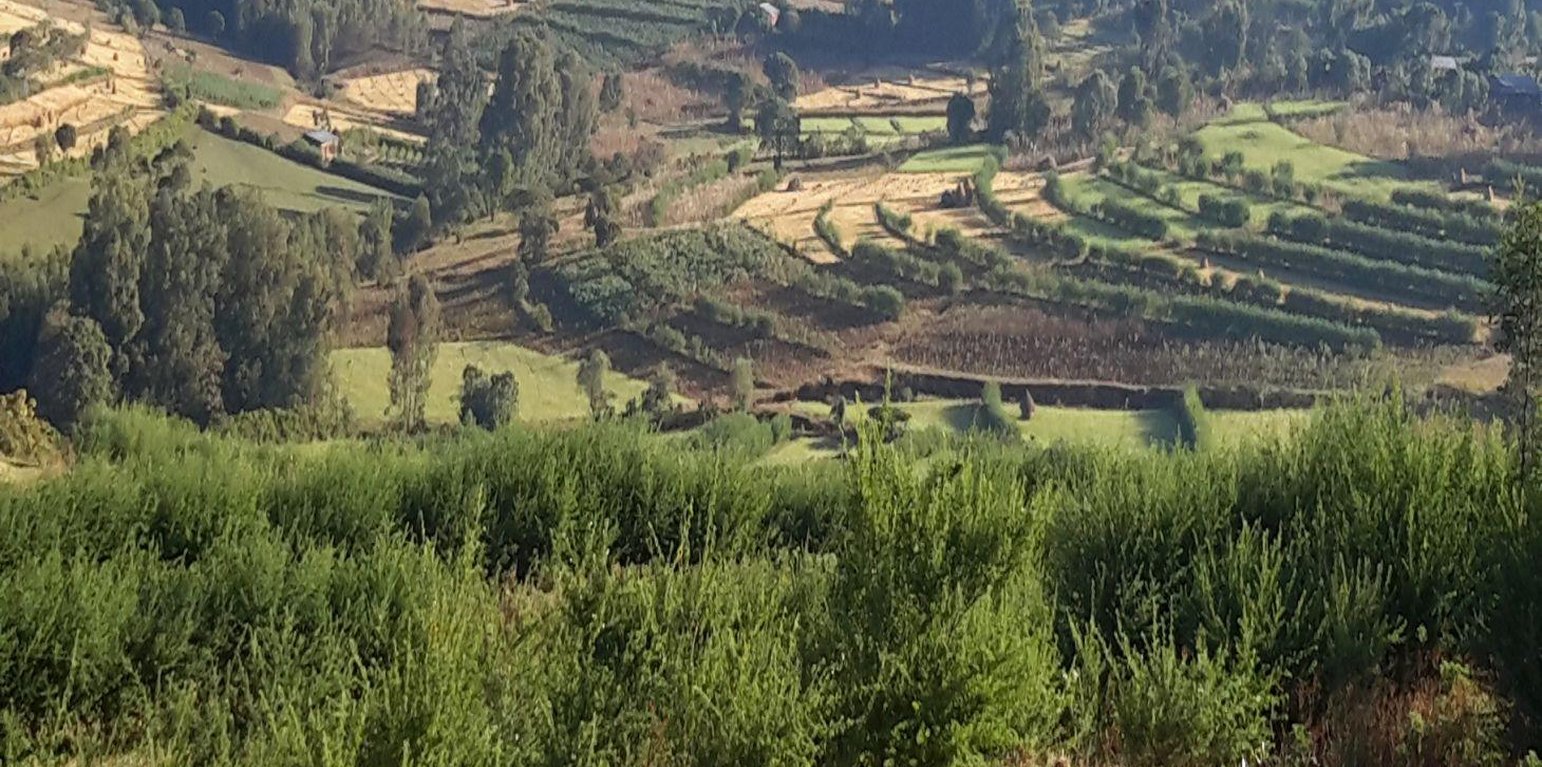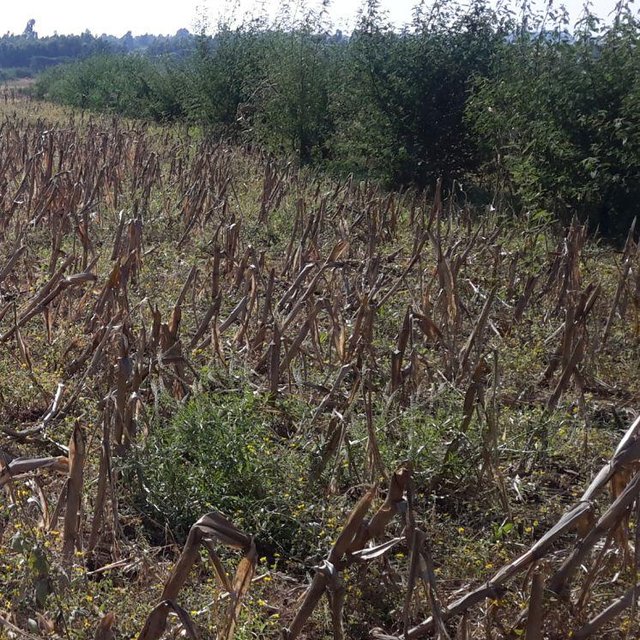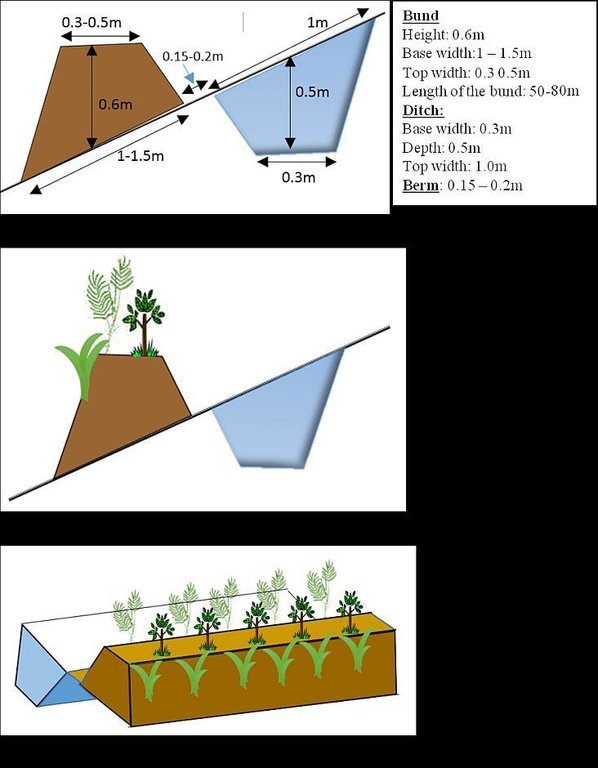



Vegetated graded soil bund is a practice or soil conservation technology for cultivated lands and constructed by excavating graded channel and form embankment. It is practiced in areas where there is excess runoff to be disposed and where there is no stones available for construction. The design specifications (ditch gradient, width and height) and layout (spacing/vertical interval) vary on the amount of excess runoff and slope of the land. Soil bund construction begins from top of the catchment. Cut off drains are constructed on top of the catchment and where needed to drain excess runoff to well stabilized natural or man-made waterways. this helps to reduce runoff impact on gullies. The bund ditch/channel should be sufficient enough to drain excess runoff safely without causing channel erosion and creating downstream damages. At same time the embankment should be stable to withstand overflows and damage due to free grazing. One technique to stabilize bunds is to plant the embankment with grass and shrub species of multiple economic value in order to compensate production area lost by bund construction. Often, the species are preferably used for livestock feed. Thus, free grazing has to be controlled. To protect damage of channels and embankments by extreme runoff and floods, frequent supervision and maintenance is required.
The purposes are:
1) Reduce nutrient loss and soil erosion by shortening the slope length,
2) Safely drain excess runoff from upstream of gully into protected waterways,
4) Produce biomass of fodder and cash values.
Vegetated graded bunds are established by doing surveying using hand level to determine the layout of the technology along the slope. During the surveying, the position of bunds (spacing) and cutoff drains and connection to waterways are determined. Bunds are laid following 0.05% gradient and up to 80 m maximum length. The specifications of the structure are: height of bund is a minimum of 60 cm after compaction; depending on the soil, base width range between 1.0 and 1.5m; top width is between 30 and 50 cm. The construction is made across different parcels owned by different land users. If there is no natural waterways and where it is appropriate, paved waterways are constructed at every 80 m or less bund length to dispose drainage water. At the beginning of the rainy season, the embankments are covered with grass and/or shrubs either by direct sowing of seeds or planting the seedlings raised in the nurseries. Monitoring of damages due to flooding and animals, maintenance of the structure as well as replanting of dead seedlings on bunds is required to sustain the soil conservation technology.
The technology is appropriately applied in high rainfall and sub-humid areas of the sub-tropics, particularly where the soil is moderately deep and poorly drained. It is constructed on cultivated lands having slopes in the range of 3-15%. The practice can be constructed by land users. It also requires collective decision and actions to drain excess runoff through waterways. The living condition depends on subsistence crop-livestock mixed farming. On average households have 5-6 family size. Crop production is meant for home consumption with small surplus for local market. The services related to water supply, energy supply, and infrastructure are low. Besides it is an asset, animals often used to cope shocks during drought periods.
Location: Mecha, Bahirdar Zuria and Yilmana Densa, Amhara National Regional State (ANRS), Ethiopia
No. of Technology sites analysed:
Spread of the Technology:
In a permanently protected area?:
Date of implementation: less than 10 years ago (recently)
Type of introduction







| Specify input | Unit | Quantity | Costs per Unit (ETH BIRR) | Total costs per input (ETH BIRR) | % of costs borne by land users |
| Labour | |||||
| labour | ha | 1.0 | 1107.0 | 1107.0 | 79.0 |
| Equipment | |||||
| animal traction | ha | 1.0 | 4.0 | 4.0 | 100.0 |
| tools | ha | 1.0 | 300.6 | 300.6 | 50.0 |
| Plant material | |||||
| seedlings | ha | 1.0 | 32.0 | 32.0 | 100.0 |
| seeds | ha | 1.0 | 9.0 | 9.0 | 100.0 |
| compost manure | ha | 1.0 | 2.0 | 2.0 | 100.0 |
| Construction material | |||||
| stone | ha | 1.0 | 1300.0 | 1300.0 | 100.0 |
| wood | ha | 1.0 | 110.0 | 110.0 | 100.0 |
| earth | ha | 1.0 | 25.2 | 25.2 | 100.0 |
| Total costs for establishment of the Technology | 2'889.8 | ||||
| Total costs for establishment of the Technology in USD | 144.49 | ||||
| Specify input | Unit | Quantity | Costs per Unit (ETH BIRR) | Total costs per input (ETH BIRR) | % of costs borne by land users |
| Labour | |||||
| labour | ha | 1.0 | 279.0 | 279.0 | 100.0 |
| Plant material | |||||
| seedlings | ha | 1.0 | 20.0 | 20.0 | 100.0 |
| Total costs for maintenance of the Technology | 299.0 | ||||
| Total costs for maintenance of the Technology in USD | 14.95 | ||||
Crop yield increase on sedimentation area of bunds
Introduction of fodder crops on bunds
Introduction of high value forage crops
The area used for ditch construction can be taken as a loss of land
In slope classes where spacing is narrow farm operation will be hindered
Increase in income due to yield increase and fodder production
Watershed users committee established to regulate the development
Field staffs and land users aware of erosion and soil conservation
Overall effect of bunds show increase in surface water downstreams
reduction of concentrated runoff
Increase the rate of infiltration
Soil loss is reduced by breaking the slope length
In good drainage soils it increases infiltrated water and interflows
Since it helps to reduce concentration of runoff it contributes to reduce flooding
The main function of bunds is to reduce soil loss
All fields are treated with integrated bund, cutoff drain and waterways